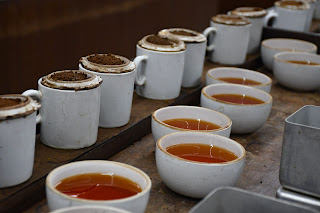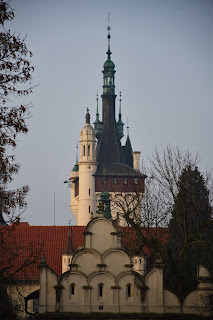India: Day 4 – Learning about Kolkata in WWII and Tea
As though a hole had been torn through the clouds, torrents of rain began to pour down just before our departure from the house at half past seven. Even our brisk leap into the Uber got us wet, and as we rode on, we feared that the rain would not stop. All of a sudden, however, it did stop, and we noticed that some parts of the city were completely dry.
The plan for the
morning was a tour of old Kolkata with Professor Tathagata, focussing on India
in the Second World War. We met him by a local Baťa store, which stands opposite from a big market housed in a red brick
colonial-era building. During the Second World War, the building was used as a
silo for rice impounded by the British. Fearful that the Japanese would use
this rice if they managed to invade India, the colonial administration decided
to confiscate it from locals living in the countryside, which quickly triggered
a massive famine across Bengal. Much of this rice was left to sit in the silos
or was sent to Chinese allies in Kunming and soldiers in Burma.
The tour gradually
wound its way north, covering aspects of the war and especially the famine. We
stood in front of the building where many protesting students and people
waiting for famine relief were shot at by Gurkha soldiers under British
command. Also killed were factory workers demanding that they be allowed to
take food to their families; they were paid in food as the British government
was low on funds. This is also why government bonds were issued to a number of
local enterprises, many of which were never repaid after India’s
independence.
The tour ended near
the big department store across the road from Esplanade Station, which – as one
of the landmarks of Kolkata – had to be obscured by tarp to confuse Japanese
pilots. The Victoria Memorial was covered by dung, as it was feared that paint
would damage the marble.
Most of the group
headed directly home after the tour, but I figured that since we were already
in the north, I would make a little excursion. First, I walked along the broad
roads of the old financial district, which houses several banks and the old
post office. All around me were imposing colonial buildings with walls painted
white or made of red bricks. Juxtaposing these, however, were a number of
street stalls and roadside restaurants, some of them producing so much smoke
that I could smell it from across the road.
Next, I decided I
would visit the Maghen David Synagogue, a beautiful red brick building and the
erewhile centre of Jewish life in Kolkata. Jews have lived in India from
Biblical times, and the Jewish diaspora of Kolkata is very diverse. Many
Sephardim Jews arrived in early modern times from the Iberian Peninsula, and
more Jewish people came with the Brits in the nineteenth and twentieth
centuries. I also understand there was a sizeable Baghdadi Jewish population in
the city.
Finding the synagogue,
however, proved to be quite a challenge. The whole area around the building is
a market, where stalls line the streets, obscure the entrances to buildings,
and push pedestrian traffic out into the road. I forged my way through the
bustling surroundings and made two semicircles around the synagogue before I
finally came across an entrance: it was hidden behind a stall, and I had to
gesture at the owners to ask whether they could let me through.
There was an eery
silence in the synagogue. There was not a single tourist, though a few
caretakers seemed to be milling about. One of them approached me and asked me
whether I was Jewish. When I said I was not, I was offered a kippa, and I was told
that I could walk all around the building, including the second floor. It did
not look much like the pictures: the windows had no stained glass, there was no
chandelier, and the fans were hanging uncharacteristically low above the
ground.
As I prepared to
leave, the caretaker had me sign a guestbook and mentioned a donation box, adding
in very broken English that the congregation is very small. I felt obliged to
leave a banknote and thanked the caretaker for his welcome, but before I left
the door, the worker started asking whether I was continuing to another
synagogue. I knew there was another synagogue to the south, so I lied and said
that I was already there. The caretaker did not seem content with this answer
and instead of letting me leave through the main exit, he helped me through the
southern side door.
When I exited the
synagogue and looked ahead of myself, it finally dawned on me that I had not
seen the Maghen David Synagogue at all. As I would learn later, north of the
Maghen David Synagogue stands the smaller Neveh Shalome Synagogue, through
which one can directly enter the grounds of the former. Sitting there was a
police officer, who approached me as soon as I drew near to the entrance.
Again, she asked whether I was Jewish, and when I said I was not, she asked me
to leave my bag at the door. I hesitated, since my wallet and camera were in
the bag, but the officer would not have it any other way, so I took both out
and made to take them with me.
Upon spotting my
camera, however, the officer smiled awkwardly and asked one more time whether I
was Jewish. I briefly contemplated lying but decided against it, as I could not
imagine what the repercussions of such a lie might be. She told me to sit down
and wait. A few minutes later, she appeared in the company of a custodian – a
small elderly man with a white beard, a long kurta, and a forward stoop. He was
similarly adamant that I should not take pictures but permitted me to take my
camera inside; I slung it over my back to make clear that I would not use it.
Perhaps in return for this show of good faith, the custodian permitted me to
take pictures on my phone.
This synagogue was
exactly what I remembered from the pictures: a magnificent building in the
style of an ornate Italian church, with a multi-tiered chandelier and elegant
arches. It was much larger than the first and had space for multiple rows for
prayer in the upper floor, which is, I assume, where the women prayed.
The two synagogues
were the only buildings I would be able to enter on this little trip. At the
nearby Armenian Church, I was turned away at the gate. I was not able to find
out when the opening times were, but I would likely not have been able to make
them anyway. I was also turned away at the Cathedral of the Most Holy Rosary,
but at least I found out that the place of worship was open on Sundays. The
official who told me spoke English quite decently, and I might have been able
to bribe my way in had there not been so many other people around.
I rejoiced when I
managed to leave the busy market area with its narrow streets and loud
salesmen. I had breathed in so many fumes and worn myself out so completely
that my head was spinning; I wondered what would happen if I passed out
straight onto the ground. Once I reached the wide crossing at Nakhoda Masjid, I
finally called an Uber, which to my dismay did not have any air conditioning.
The open windows made me a prime target for the attention of a few beggars, who tend
to frequent congested crossings. One particularly insistent person even reached in a few times to touch me, and walked around the car for
one more attempt when I shifted myself out of reach.
Our group ate lunch at
Sienna Café, a cosy place with a very international selection of food. We
stuffed ourselves so much that for dinner, we managed to consume just a few
meals ordered from Peter the Cat, along with a couple of leftovers. Once our
afternoon meal was over, we headed back to the north of Central Kolkata. As a
well-connected tea merchant, Sparsh had arranged for us to visit the J. Thomas
and Company tea auction house (the building is also known as Nilhat house, the
first of these words translating to “Blue Market” in reference to indigo, which
was once traded on its premises).
Inside, we were shown
the hall where bids used to be placed on tea. Since the pandemic, the process
has moved online, but Sparsh and the auctioneer guiding us – Mr. Bose – said
they were planning to reinstitute an annual auction as a special media event.
We also visited the halls in which teas are tasted: they were set out in tins
with four-number digits and arranged according to various criteria like origin
and oxidisation. Finally, we were brought to the fancy rooms in which important
guests are received; they were decorated with auction-related memorabilia like
gavels, as well as the paraphernalia used to serve tea, such as a silver
samovar.
I joined Sparsh and
Jeanne on our journey back to the house, making a stop by Sparsh’s office. The
contracts with his Shark Tank India investors had finally been finalised, and I
just happened to be there to capture the moment on camera. It was quite
exciting; knowing about all of my friend’s plans, it felt like being present for
the birth of a chaebol.



















Comments
Post a Comment